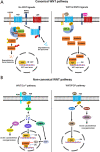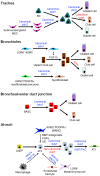WNT Signaling in Lung Repair and Regeneration
- PMID: 32807748
- PMCID: PMC7528681
- DOI: 10.14348/molcells.2020.0059
WNT Signaling in Lung Repair and Regeneration
Abstract
The lung has a vital function in gas exchange between the blood and the external atmosphere. It also has a critical role in the immune defense against external pathogens and environmental factors. While the lung is classified as a relatively quiescent organ with little homeostatic turnover, it shows robust regenerative capacity in response to injury, mediated by the resident stem/progenitor cells. During regeneration, regionally distinct epithelial cell populations with specific functions are generated from several different types of stem/progenitor cells localized within four histologically distinguished regions: trachea, bronchi, bronchioles, and alveoli. WNT signaling is one of the key signaling pathways involved in regulating many types of stem/progenitor cells in various organs. In addition to its developmental role in the embryonic and fetal lung, WNT signaling is critical for lung homeostasis and regeneration. In this minireview, we summarize and discuss recent advances in the understanding of the role of WNT signaling in lung regeneration with an emphasis on stem/progenitor cells.
Keywords: WNT signaling; lung homeostasis; lung regeneration; lung stem/progenitor cells; β-catenin.
Conflict of interest statement
The authors have no potential conflicts of interest to disclose.
Figures




Similar articles
-
R-Spondin2, a Positive Canonical WNT Signaling Regulator, Controls the Expansion and Differentiation of Distal Lung Epithelial Stem/Progenitor Cells in Mice.Int J Mol Sci. 2022 Mar 13;23(6):3089. doi: 10.3390/ijms23063089. Int J Mol Sci. 2022. PMID: 35328508 Free PMC article.
-
The roles of Wnt/β-catenin pathway in tissue development and regenerative medicine.J Cell Physiol. 2018 Aug;233(8):5598-5612. doi: 10.1002/jcp.26265. Epub 2018 Mar 7. J Cell Physiol. 2018. PMID: 29150936 Review.
-
Recent Advances in Lgr5+ Stem Cell Research.Trends Cell Biol. 2018 May;28(5):380-391. doi: 10.1016/j.tcb.2018.01.010. Epub 2018 Feb 21. Trends Cell Biol. 2018. PMID: 29477614 Review.
-
β-catenin/Wnt signaling controls progenitor fate in the developing and regenerating zebrafish retina.Neural Dev. 2012 Aug 24;7:30. doi: 10.1186/1749-8104-7-30. Neural Dev. 2012. PMID: 22920725 Free PMC article.
-
Noncanonical Wnt signaling plays an important role in modulating canonical Wnt-regulated stemness, proliferation and terminal differentiation of hepatic progenitors.Oncotarget. 2017 Apr 18;8(16):27105-27119. doi: 10.18632/oncotarget.15637. Oncotarget. 2017. PMID: 28404920 Free PMC article.
Cited by
-
Airway Basal Cells, Protectors of Epithelial Walls in Health and Respiratory Diseases.Front Allergy. 2021 Nov 19;2:787128. doi: 10.3389/falgy.2021.787128. eCollection 2021. Front Allergy. 2021. PMID: 35387001 Free PMC article. Review.
-
Wnt signaling in liver regeneration, disease, and cancer.Clin Mol Hepatol. 2023 Jan;29(1):33-50. doi: 10.3350/cmh.2022.0058. Epub 2022 Jul 4. Clin Mol Hepatol. 2023. PMID: 35785913 Free PMC article. Review.
-
Suppressive effects of valproic acid on caudal fin regeneration in adult zebrafish.Anim Cells Syst (Seoul). 2020 Dec 24;24(6):349-358. doi: 10.1080/19768354.2020.1860126. Anim Cells Syst (Seoul). 2020. PMID: 33456719 Free PMC article.
-
Recent advances and applications of human lung alveolar organoids.Mol Cells. 2024 Dec;47(12):100140. doi: 10.1016/j.mocell.2024.100140. Epub 2024 Oct 28. Mol Cells. 2024. PMID: 39490990 Free PMC article. Review.
-
Claudin-18 expression under hyperoxia in neonatal lungs of bronchopulmonary dysplasia model rats.Front Pediatr. 2022 Oct 10;10:916716. doi: 10.3389/fped.2022.916716. eCollection 2022. Front Pediatr. 2022. PMID: 36299696 Free PMC article.
References
-
- Basil M.C., Katzen J., Engler A.E., Guo M., Herriges M.J., Kathiriya J.J., Windmueller R., Ysasi A.B., Zacharias W.J., Chapman H.A., et al. The cellular and physiological basis for lung repair and regeneration: past, present, and future. Cell Stem Cell. 2020;26:482–502. doi: 10.1016/j.stem.2020.03.009. - DOI - PMC - PubMed
Publication types
MeSH terms
LinkOut - more resources
Full Text Sources

